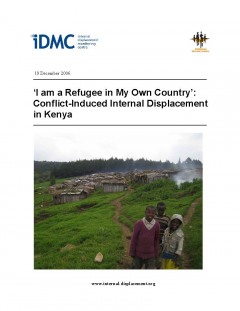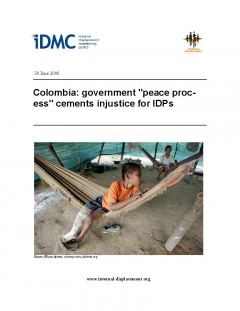Location
About IDMC
The Internal Displacement Monitoring Centre (IDMC) is the global leader in the provision of data and analysis on internal displacement. Since our establishment in 1998, we have been committed to offering a rigorous, transparent and independent service to the international community and to informing policy and operational decisions that can improve the lives of the millions of people living in internal displacement, or at risk of becoming displaced in the future.
Our mission
To provide high-quality data, analysis and expertise on internal displacement with the aim of informing policy and operational decisions that can reduce the risk of future displacement and improve the lives of internally displaced persons (IDPs) worldwide.
What we do
- We provide verified, consolidated and multi-sourced estimates of the number of people internally displaced or at risk of becoming displaced by conflict, violence, disasters and development projects across the world.
- We complement this global data with interdisciplinary research into the drivers, patterns and impacts of internal displacement across different country situations, contexts and scenarios.
- Using this evidence, we provide tailor-made advice and support to inform global, regional and national policy-making.
Our achievements
Thanks to our unique, internationally endorsed mandate, we have played a convening role and provided leadership on IDP data collection and analysis processes across the world, and consolidated multiple sources of information on the scale, scope and patterns of displacement to provide a comprehensive and global picture of this phenomenon.
We have worked with national governments, UN agencies and expert centres to find effective and lasting solutions to internal displacement. Our global data and expertise have served to keep this issue visible on the international agenda, and have shaped some of the world’s key global and regional policy frameworks of relevance to this issue, including on humanitarian action, climate change and disaster risk reduction. Our data is used for setting targets and measuring progress towards these frameworks.
With twenty years’ experience monitoring and analysing internal displacement often in highly sensitive and hard-to-reach areas, we have developed innovative and specialist tools to expand our global coverage and to continuously improve our understanding of this phenomenon.
Our tools
We provide different types of analytical tools for different purposes, and adjust the temporal and spatial scale of our reporting to inform operational and policy decision-making at different levels - from the local to the global level - and across different sectors, from prevention and risk reduction, to humanitarian programming, post-crisis recovery and sustainable development. We pride ourselves on being transparent with the data that we use, and independent in the analysis that we provide.
Our tools include:
- The Global Report on Internal Displacement (GRID). Our annual flagship report synthesises the latest statistics, country/situation assessments, thematic and policy analyses. Each year it presents the most up-to-date estimates of new displacements by conflict and disasters, and the total cumulative numbers of IDPs worldwide. The GRID is the global reference for internal displacement data and analysis and is widely used by policy-makers national governments, UN agencies, international NGOs, journalists and academics.
- Internal Displacement Updates (IDUs). ‘Flash’ updates on new displacement events across the globe, published on a daily basis on an interactive map on IDMC’s website’s main homepage.
- Country pages. An overview of latest figures and analysis of internal displacement per country, including overview of causes and patterns of displacement, priority needs and vulnerabilities, and government policy and operational responses at national and sub-national level.
- Research papers. Thematic, country and case study reports exploring different dimensions of internal displacement. Current research priorities include: 1) patterns of internal to cross-border displacement; 2) economic costs of internal displacement; 3) patterns of urban internal displacement; 4) displacement in the context of slow-onset disasters.
- Global Disaster Displacement Risk Platform. An innovative tool based on IDMC’s probabilistic model for exploring and visualising disaster-related displacement risk metrics. This platform reveals how many people are likely to be displaced per country per year in absolute terms, and in relation to the size of the country’s population, in total and for individual hazards. Using this tool, users can also analyse the risk associated with specific displacement events within a given country, such as a cyclone that displaces 100,000 people or an earthquake that displaces 50,000 people.
- Displacement Data Exploration Tool. A tool that lets users generate their own custom charts using IDMC’s displacement data, UNHCR’s refugee data and all indicators from the World Bank’s open data catalogue.
- Internal Displacement Event Tagging and Clustering Tool (IDETECT). Using natural language processing and machine learning algorithms, IDETECT reads thousands of articles and UN and government reports per day and extracts from them key pieces of information about the cause of displacement and the number and location of people reportedly displaced. Using IDETECT, we can increase the scope of our monitoring and better identify incidents of new or secondary displacement.
- Satellite imagery analysis. In hard-to-reach areas and situations where there are no actors on the ground who can collect and share data on internal displacement, we and our partners have developed tools to detect and quantify displacement by analysing high-resolution satellite images of housing damage and destruction.
Members:
Resources
Displaying 26 - 30 of 31Book of Life Stories: Para Que Se Sepa (Let It Be Known)
Para Que Se Sepa – in English Let It Be Known – is a compilation of life stories told by people displaced by Colombia’s years of internal armed conflict and massive human rights violations.
Forced migration/internal displacement in Burma - with an emphasis on government-controlled areas
This report is a preliminary exploration of forced migration/internal displacement in Burma/Myanmar in two main areas. The first is the status in terms of international standards, specifically those embodied in the Guiding Principles on Internal Displacement, of the people who leave home not because of conflict or relocation orders, but as a result of a range of coercive measures which drive down incomes to the point that the household economy collapses and people have no choice but to leave home.
‘I am a Refugee in My Own Country’: Conflict-Induced Internal Displacement in Kenya
Internal displacement in Kenya is a complex and multi-faceted social problem that revolves around and reflects unresolved issues of land and property, as well as the struggle for the control of political and economic resources. (...)
Download the report
Displaced by the Wall: Forced displacement as a Result of the West Bank Wall and its Associated Regime
Report produced in conjunction with the Badil Resource Center for Palestinian Residency and Refugee Rights and assessing the forced displacement of Palestinian communities as a result of the West Bank Wall and its regime.
Download the report
Colombia: government "peace process" cements injustice for IDPs
Forced displacement in Colombia is primarily a way to seize agricultural land from peasants and small farmers, and only to a lesser degree the unintended consequence of fighting between warring parties. (...)
Download the report






